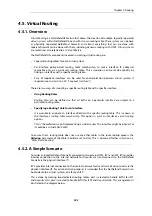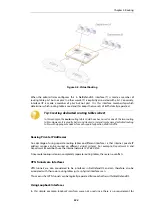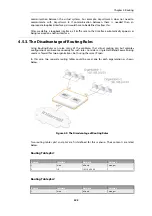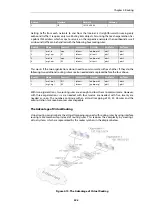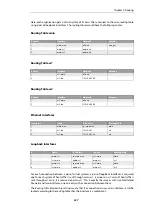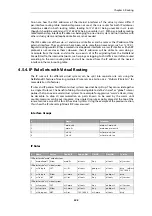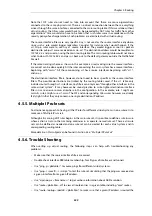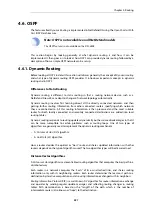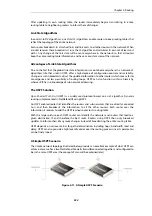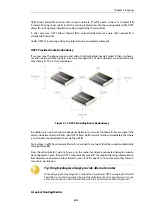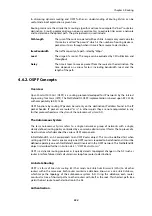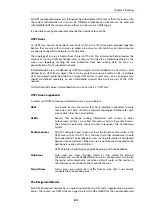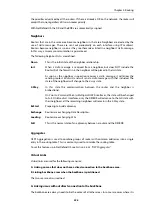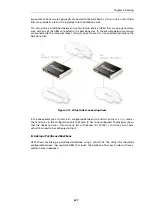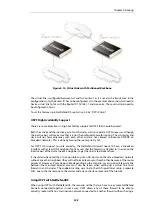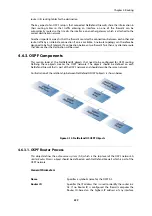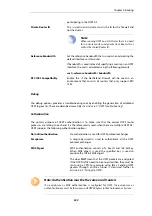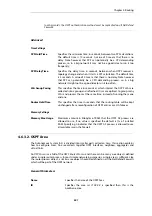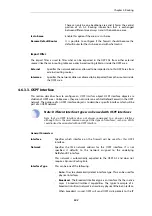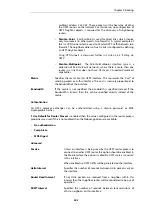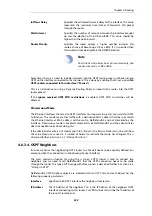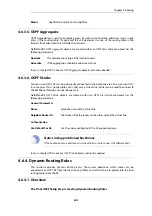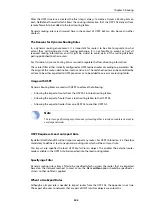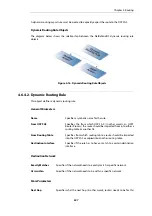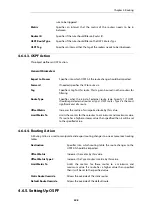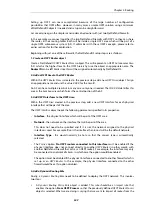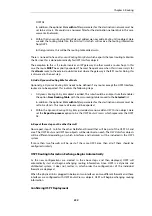
the priorities advertised by all the routers. If there is already a DR on the network, the router will
accept that one, regardless of its own router priority.
With NetDefendOS, the DR and the BDR are automatically assigned.
Neighbors
Routers that are in the same area become neighbors in that area. Neighbors are elected by the
use of
Hello
messages. These are sent out periodically on each interface using IP multicast.
Routers become neighbors as soon as they see themselves listed in a neighbor's
Hello
message.
In this way, a two way communication is guaranteed.
The following
Neighbor States
are defined:
Down
This is the initial state of the neighbor relationship.
Init
When a
Hello
message is received from a neighbor, but does NOT include the
Router ID of the firewall in it, the neighbor will be placed in the
Init
state.
As soon as the neighbor in question receives a
Hello
message it will know the
sending router's
Router ID
and will send a
Hello
message with that included. The
state of the neighbors will change to the
2-way
state.
2-Way
In this state the communication between the router and the neighbor is
bidirectional.
On
Point-to-Point
and
Point-to-Multipoint
OSPF interfaces, the state will be changed
to
Full
. On
Broadcast
interfaces, only the DR/BDR will advance to the
Full
state with
their neighbors, all the remaining neighbors will remain in the 2-Way state.
ExStart
Preparing to build adjacency.
Exchange
Routers are exchanging Data Descriptors.
Loading
Routers are exchanging LSAs.
Full
This is the normal state of an adjacency between a router and the DR/BDR.
Aggregates
OSPF Aggregation is used to combine groups of routes with common addresses into a single
entry in the routing table. This is commonly used to minimize the routing table.
To set this feature up in NetDefendOS, see
Section 4.6.3.5, “OSPF Aggregates”
Virtual Links
Virtual links are used for the following scenarios:
A. Linking an area that does not have a direct connection to the backbone area.
B. Linking backbone areas when the backbone is partitioned.
The two uses are discussed next.
A. Linking areas without direct connection to the backbone
The backbone area always needs to be the center of all other areas. In some rare cases where it is
Chapter 4: Routing
336
Summary of Contents for NetDefendOS
Page 30: ...Figure 1 3 Packet Flow Schematic Part III Chapter 1 NetDefendOS Overview 30 ...
Page 32: ...Chapter 1 NetDefendOS Overview 32 ...
Page 144: ...Chapter 2 Management and Maintenance 144 ...
Page 284: ...Chapter 3 Fundamentals 284 ...
Page 392: ...Chapter 4 Routing 392 ...
Page 419: ... Host 2001 DB8 1 MAC 00 90 12 13 14 15 5 Click OK Chapter 5 DHCP Services 419 ...
Page 420: ...Chapter 5 DHCP Services 420 ...
Page 573: ...Chapter 6 Security Mechanisms 573 ...
Page 607: ...Chapter 7 Address Translation 607 ...
Page 666: ...Chapter 8 User Authentication 666 ...
Page 775: ...Chapter 9 VPN 775 ...
Page 819: ...Chapter 10 Traffic Management 819 ...
Page 842: ...Chapter 11 High Availability 842 ...
Page 866: ...Default Enabled Chapter 13 Advanced Settings 866 ...
Page 879: ...Chapter 13 Advanced Settings 879 ...


